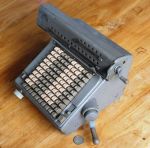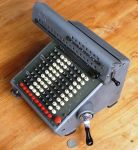

Introduction
My Numeria 7101
My Numeria 9200
Video
The Numeria Mechanism
History
Model Numbers
Promotional Material
Advertisements
Patents
Links
Numeria calculators are full-keyboard calcuulators, made in Milan, Italy. Outwardly they are very similar to Monroe calculators, and they function in exactly the same way. They use a different actuating mechanism however.
This is a Numeria 7101 which has the serial number NU 32466. It has a full keyboard with 10 columns, each with keys 0 to 9. Above the keyboard is a carriage with a 14-digit results register and a 6-digit revolution counter. At the front-left of the machine is a knob that can be rotated to shift the carriage in either direction. There is a crank on the right, angled towards the the operator. Turning this adds the input to the register, or subtracts it when turned the other way. To the right of the keyboard is a switch that can be set to Addition/Subtraction or to Multiplication/Division. In the former setting, the keyboard input is automatically cleared after every turn of the crank. In the latter mode the input is retained, allowing for repeated additions/subtractions of the input, i.e. multiplication and division. Below the switch there is a button with which you can clear the keyboard input. The carriage has a single clearing handle. Turning it one way clears the counter, the other way clears the results register.
The revolution counter does not have a carry mechanism. Each of its number wheels has white digits going from 0 to 9 in one direction for addition. In the other direction it has the digits 1 to 9 in red to indicate subtraction. This is fine in most cases where you do only additions or only subtractions. When mixing the two, things get a little problematic. For example, using shortcut multiplication to multiply by 9 would result in the counter displaying 11 instead of 09. A common workaround for this problem is to use the leftmost digits of the main register as a revolution counter. To do so, you need to permanently enter a 1 in the leftmost keyboard column. Activating the small switch on the left will allow that 1 to be excluded from all keyboard resets.
The carriage is easy to remove by taking out the rod it hinges on. The base has a panel that can be removed. The outer casing is held on by a couple of screws in the side panels. The axial pinwheel mechanism is explained in detail below.
This is a Numeria 9200 which has the serial number 7039. Its design is very slightly different to the 7101 above, but it functions in exactly the same way. It has an 8-digit counter, and an 18-digit register. It does not have the "Item Count" functionality where you can lock down a 1 in the left-most key column.
It is in good condition, except for a dent on the back-right edge where it was probably dropped on the floor. This knock may also have slightly bent something in the carriage, as the clearing lever moves a bit stiffly.
The carriage is easily detached by removing a screw, which reveals the underlying mechanism. The mechanism is explained in detail below.
This video shows my Numeria machines, and compares their mechanism to that of the Monroe.
The Numeria mechanism is best explained by first taking a look at the Monroe mechanism it is based on. The Monroe calculator used a split stepped drum mechanism to transfer the input to the register wheels, and a rotating drum that triggered the carry operation on the digits in the correct order, rippling from right to left. For each digit the carry drum has a pin that can shift to the left, and then engage with the gear wheel of the next digit, incrementing it. It is like a single pin of a pinwheel. When a digit overflows a mechanical switch is thrown, and when the carry pin on the drum passes by it is pushed left by the switch, and then increments the next digit.
The mechanism of the Numeria does away with the stepped drum, and extends the carry drum mechanism to do the same duty. Instead of just one pin for the carry, it now also has 9 more similar sliding pins to add the input digit. It acts like a special kind of pinwheel. A normal pinwheel extends pins radially outwards, to act as the teeth of a gear. The pinwheels inside the Numeria extend their pins sideways, in the axial direction. When a key is pressed, a small cam is positioned such that when the drum is later turned, the correct number of pins will be extended to add the input number to the number wheel.
The 9 pins are split into two groups, 5 that slide from the left and 4 that slide from the right, into the path of the gear wheel. Below is a diagram that shows which pins are used for each value. From the left the number of extended pins can be 0, 1, 4 or 5, and from the right 0, 2 or 4 pins. With the right combination every number from 0 to 9 can be produced. I assume this split was done because otherwise the mechanism for selecting them would need to be much more precise.
| 0 | 1 | 2 | 3 | 4 | 5 | 6 | 7 | 8 | 9 | ||||||||||||||||||||||||||||||||||||||||||||||||||||||||||||||||||||||||||||||||||||||||||||||||||||||||||||||||||||||||||||||||||||||||||||||||||||||||||||||||||||||||||||||||||||||||||||||||||||||||||||||||||||||||||||||||||||||||||||||||||||||||||||||||||||||||||||||||||||||||||||||||||||||||||||||||||||||||||||||||||||||||||||||||||||||||||||||||||||||||||||||||||||||||||||||||||||||||||||||||||||||||||||||||||||||||||||||||||||||||||||||||||
|---|---|---|---|---|---|---|---|---|---|---|---|---|---|---|---|---|---|---|---|---|---|---|---|---|---|---|---|---|---|---|---|---|---|---|---|---|---|---|---|---|---|---|---|---|---|---|---|---|---|---|---|---|---|---|---|---|---|---|---|---|---|---|---|---|---|---|---|---|---|---|---|---|---|---|---|---|---|---|---|---|---|---|---|---|---|---|---|---|---|---|---|---|---|---|---|---|---|---|---|---|---|---|---|---|---|---|---|---|---|---|---|---|---|---|---|---|---|---|---|---|---|---|---|---|---|---|---|---|---|---|---|---|---|---|---|---|---|---|---|---|---|---|---|---|---|---|---|---|---|---|---|---|---|---|---|---|---|---|---|---|---|---|---|---|---|---|---|---|---|---|---|---|---|---|---|---|---|---|---|---|---|---|---|---|---|---|---|---|---|---|---|---|---|---|---|---|---|---|---|---|---|---|---|---|---|---|---|---|---|---|---|---|---|---|---|---|---|---|---|---|---|---|---|---|---|---|---|---|---|---|---|---|---|---|---|---|---|---|---|---|---|---|---|---|---|---|---|---|---|---|---|---|---|---|---|---|---|---|---|---|---|---|---|---|---|---|---|---|---|---|---|---|---|---|---|---|---|---|---|---|---|---|---|---|---|---|---|---|---|---|---|---|---|---|---|---|---|---|---|---|---|---|---|---|---|---|---|---|---|---|---|---|---|---|---|---|---|---|---|---|---|---|---|---|---|---|---|---|---|---|---|---|---|---|---|---|---|---|---|---|---|---|---|---|---|---|---|---|---|---|---|---|---|---|---|---|---|---|---|---|---|---|---|---|---|---|---|---|---|---|---|---|---|---|---|---|---|---|---|---|---|---|---|---|---|---|---|---|---|---|---|---|---|---|---|---|---|---|---|---|---|---|---|---|---|---|---|---|---|---|---|---|---|---|---|---|---|---|---|---|---|---|---|---|---|---|---|---|---|---|---|---|---|---|---|---|---|---|---|---|---|---|---|---|---|---|---|---|---|---|---|---|---|---|---|---|---|---|---|
|
|
|
|
|
|
|
|
|
| ||||||||||||||||||||||||||||||||||||||||||||||||||||||||||||||||||||||||||||||||||||||||||||||||||||||||||||||||||||||||||||||||||||||||||||||||||||||||||||||||||||||||||||||||||||||||||||||||||||||||||||||||||||||||||||||||||||||||||||||||||||||||||||||||||||||||||||||||||||||||||||||||||||||||||||||||||||||||||||||||||||||||||||||||||||||||||||||||||||||||||||||||||||||||||||||||||||||||||||||||||||||||||||||||||||||||||||||||||||||||||||||||||
| 0+0 | 1+0 | 0+2 | 1+2 | 0+4 | 5+0 | 4+2 | 5+2 | 4+4 | 5+4 |
Another difference from the traditional pinwheel is that the pins are extended as they pass the stationary cam set by the keyboard, and are automatically retracted immediately afterwards. On a traditional pinwheel the pins remain extended for the whole revolution. In this aspect it resembles the "adapting segment" mechanism of the Marchant XL.
The Lagomarsino company was a supplier of office equipment, founded in 1896 in Milan by Enrico Lagomarsino, and over the years they distributed various mechanical calculators. In 1937 they decided to produce their own calculators instead of importing them, so they had F.A.I. (Fabbrica Addizionatrice Italiana, Milan) manufacture licensed copies of the Swedish Addo-X adding listing machine. These were sold by Lagomarsino under the brand name Totalia. It is not clear to me whether FAI was really an independent company, or whether it was set up by Lagomarsino for the purpose of making these machines. Eventually the two companies merged. The Totalia machines evolved further, but were always 10-key adding-listing machines.
In the early 1930s P.S.I.C. (Primo Stabilimento Italiano Calcolatrici, Pavia) produced a calculator called the Logistea which looked similar to the older Monroe full-keyboard calculators (models D to G). Only a small number of machines were produced before this small company was bought by Lagomarsino in 1935, presumably with the intent to develop the calculator further and market it. It wasn't until 1940 that production started, with a completely new model, with a much more modern design, but functionally still resembling the Monroe calculators. These machines were at first produced by SICMU (Società Italiana Commercio Macchine Ufficio, Milan), and distributed by Lagomarsino under the Numeria brand. As with FAI, it is not clear how independent this company was, but eventually it ceased to exist and production was taken over by FAI at first, and then Lagomarsino.
I have not been able to confirm that the axial pinwheel mechanism of the Numeria machines originated with the Logistea, but I think it very likely.
In the 1970s calculator production collapsed, and the FAI factories produced other items for Lagomarsino, such as fountain pens and other office equipment. I do not know exactly when Lagomarsino stopped trading, but it seems that by the 1980s it was gone.
The Numeria calculators have 4-digit model numbers. Each digit has a specific meaning.
Below are descriptions and photos of the promotional material that I have for the Lagomarsino machines.
Universal Tasten-Rechenmaschine
Procento N.V., Amsterdam
1950-1960?
Form 171
1-sided flyer
210mm × 297mm
This single page flyer promotes the Numeria 9100 and 9200. It is in German, but used by the Dutch office machine reseller Procento in Amsterdam.
Totalia Numeria
1950-1960?
4-page leaflet
139mm × 224mm
This small leaflet promotes the Totalia, models 3201, 1201, 2201, 2301, and 4201, as well as the Numeria 9101, 9201, and 9901. It is in Dutch, but does not have the name/address of the reseller that used it - the space where they can place a stamp is blank.
Here are a few advertisements taken from various online archives.
Italian patents have not been as extensively digitised as those of most other countries, so it is difficult to find the original patents for the Numeria and the Logistea.
| Patent | Filing date | Priority date | Name | Description |
|---|---|---|---|---|
| DE 722,016 | 01-07-1938 | 14-05-1942 | Angelo Raimondi (SICMU) | Numeria Calculator.
See also: CH 209,384; FR 851,750 |
© Copyright 2019 Jaap Scherphuis, mechcalc a t jaapsch d o t net.